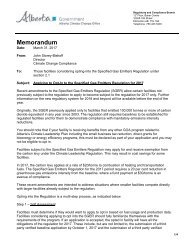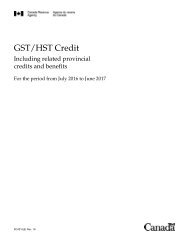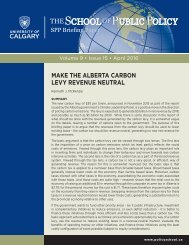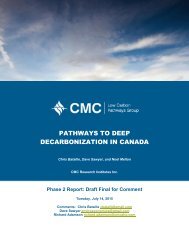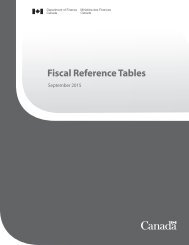China’s National Emissions Trading System
Chinas_National_ETS_Implications_for_Carbon_Markets_and_Trade_ICTSD_March2016_Jeff_Swartz
Chinas_National_ETS_Implications_for_Carbon_Markets_and_Trade_ICTSD_March2016_Jeff_Swartz
Create successful ePaper yourself
Turn your PDF publications into a flip-book with our unique Google optimized e-Paper software.
Global Economic Policy and Institutions<br />
7<br />
3. THE GROWTH OF CARBON MARKETS<br />
3.1 Carbon Market Developments around<br />
the World<br />
To date, 56 jurisdictions, including 35 national<br />
and 21 subnational jurisdictions, have put a<br />
price on carbon through an ETS. By early 2016,<br />
jurisdictions accounting for 40 percent of global<br />
GDP had introduced an ETS. 16 Many economists<br />
and policymakers have concluded that emissions<br />
trading is a powerful policy tool as it is a<br />
proven cost-effective approach of reaching an<br />
emissions reduction cap or target. Unlike a<br />
tax, it sends a clear market-driven price signal<br />
to business and investors allowing them to<br />
measure climate abatement investments over<br />
a long-term time horizon. It sets a cap on<br />
emissions, which is meant to specifically deliver<br />
a government’s emissions reduction goal. It is a<br />
“name and shame” approach to climate policy:<br />
any deviation from the cap by the government<br />
would automatically create public scrutiny<br />
unless the cap is tightened, and any company<br />
that does not fulfil their compliance obligations<br />
under the ETS is penalised by the regulator.<br />
<strong>Emissions</strong> trading provides long-term clarity for<br />
businesses about the government’s target and<br />
sets predictable compliance periods. This allows<br />
companies to adequately prepare for emissions<br />
reductions investments and shift funding away<br />
from inefficient, high-emissions production.<br />
While emissions trading is a clear policy choice<br />
for a large number of jurisdictions committed<br />
to reducing GHG emissions, it is not a new<br />
policy concept. The original concept can likely<br />
be traced as far back as 1960, when Ronald<br />
Coase wrote a groundbreaking paper titled The<br />
Problem of Social Costs, which argued that a<br />
market must be created to apply property rights<br />
to air pollution or other actions by business<br />
that cause harm to others. 17 Academics further<br />
developed these arguments in the following<br />
decades and the concept was first put into policy<br />
practice under the Montreal Protocol to phase<br />
out chlorofluorocarbons (CFCs). It was then<br />
applied under the administration of President<br />
H.W. Bush who directed the US Environmental<br />
Protection Agency to successfully reduce<br />
sulphur dioxide and nitrous oxide which were<br />
then responsible for dangerous levels of acid<br />
rain in the northeast and midwestern regions<br />
of the United States. By the 1990s, academics,<br />
policymakers, businesses, and environmental<br />
groups began referring to the concept as<br />
“cap-and-trade” and were gearing up for the<br />
first market-based policies to address carbon<br />
dioxide (CO 2<br />
) emissions.<br />
The first ETS – and still the largest until <strong>China’s</strong><br />
national system is launched – is that of the EU.<br />
It entered into force in 2005 and was predicated<br />
on the UK, Dutch, and Danish carbon markets.<br />
The EU ETS covers over 11,000 installations<br />
across the EU’s 28 member states as well as<br />
in Iceland, Norway, and Liechtenstein (the<br />
members of the European Economic Area). It<br />
currently covers around 45 percent of the bloc’s<br />
GHG emissions. 18 Following the EU ETS, carbon<br />
markets have been put into place in Alberta<br />
(2007), Switzerland and New Zealand (2008),<br />
9 northeastern US states under the Regional<br />
Greenhouse Gas Initiative - RGGI 19 (2009), Tokyo<br />
(2010), Saitama (2011), California, Québec, and<br />
Kazakhstan (2013), seven Chinese provinces<br />
and cities (five in 2013 and two in 2014), as<br />
well as South Korea (2015). 20 There are also<br />
several other countries who are exploring ETSs<br />
through their participation in the World Bank’s<br />
Partnership for Market Readiness (PMR). These<br />
include Vietnam, Mexico, Turkey, Morocco,<br />
Thailand, and Indonesia, amongst others. 21<br />
Taiwan and the Canadian provinces of Ontario<br />
and Manitoba are also working on introducing<br />
ETSs, while Japan and Mexico are exploring<br />
setting up schemes in the future.<br />
With the launch of the South Korean ETS in<br />
2015 and the recent announcement of plans<br />
for a national Chinese ETS in 2017, emissions<br />
trading is gaining traction as the preferred type<br />
of carbon pricing policy for many governments<br />
around the world, as shown in Figure 3. The<br />
number of ETSs in place has tripled since<br />
2012, going from five to 18 in just a few short<br />
years. <strong>China’s</strong> national ETS will expand the<br />
scope of global GHG emissions covered by such



